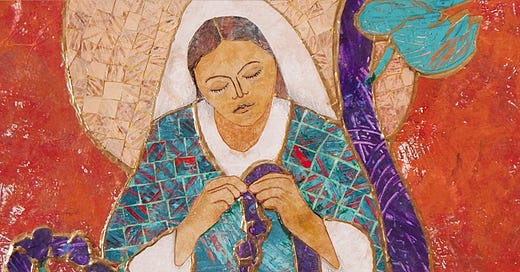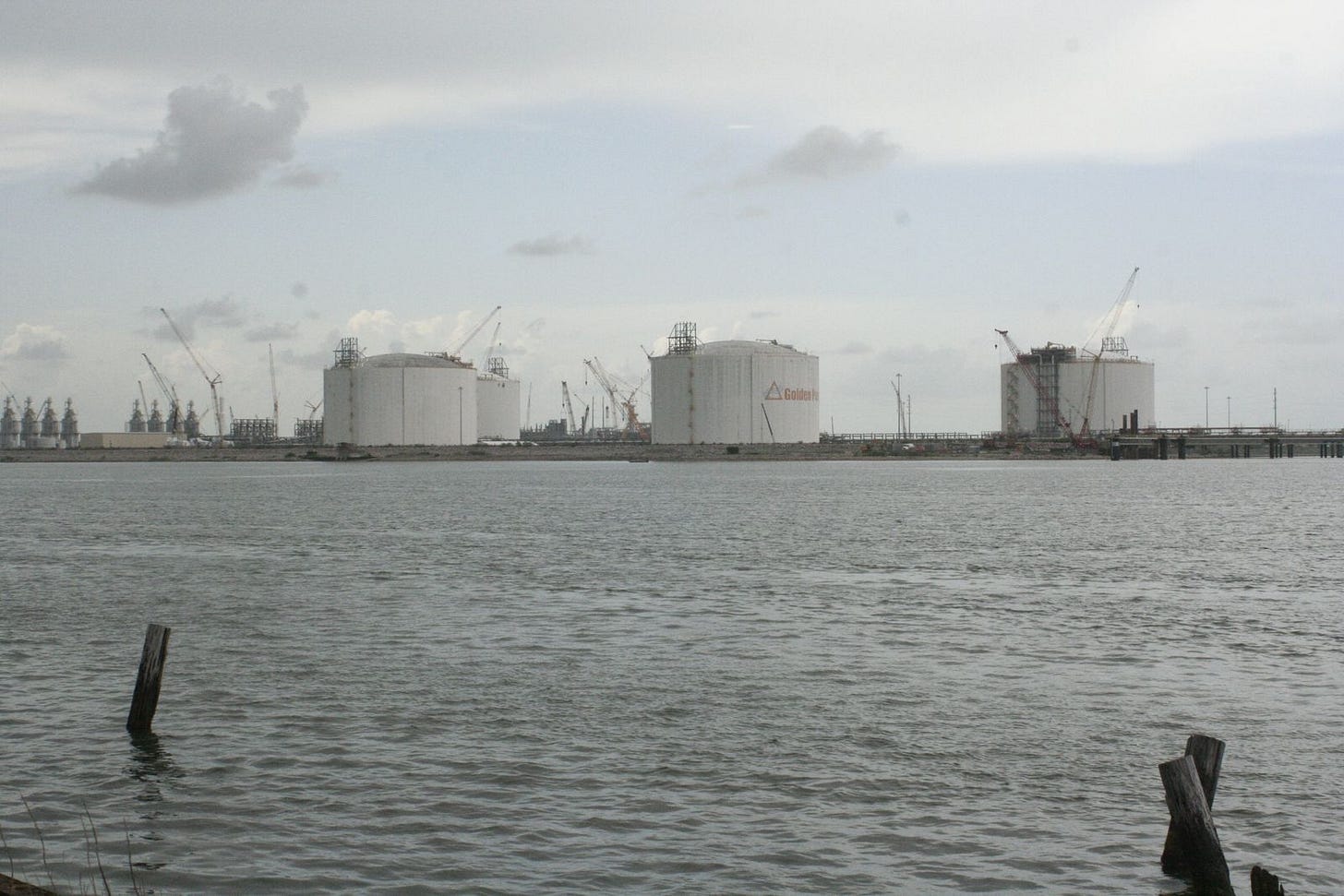Refugia Newsletter #60
A win on LNG exports, birds and bats and turbines, a Dutch floating refugium, untying knots, and blessed unrest
Refugia News
I am in Atlanta, Georgia, this weekend, joining the good people of Georgia Interfaith Power and Light for their “Green Team Summit.” I’ll be speaking, but also listening and watching for great examples of faith-based refugia work. I’ll report next time!
While here in Atlanta, I hope to catch a glimpse of that glowing orb in the sky that we haven’t seen in Michigan for… eight weeks? I don’t know. It feels like forever. Apparently, it’s been cloudy enough in the Great Lakes region this winter to merit reporting in The Guardian about mental health impacts. Fair enough. Our gloomy skies may have something to do with less ice cover on the big lakes and thus more moisture in the atmosphere—i.e., climate change. Maybe so, but we are used to sun-starved winters here; we just turn on our Happy Lites and keep gallumphing through the slush, literal or metaphorical.
While we gallumph, I’m pleased to share with you an episode of Climate Changed, the excellent podcast coming out of the BTS Center in Maine. In this episode, host Ben Yosua-Davis first interviews Margaret Wheatley, a distinguished scholar and consultant on leadership. In the second half, Ben and I discuss how Wheatley’s idea of “islands of sanity” resonates with the refugia concept. During the discussion, I mention the image of the Blessed Virgin known as Mary Untier of Knots. This image of Mary has long provided comfort for those dealing with complex, “wicked,” spiritually challenging problems—like climate change, for instance. She is a particular favorite for Pope Francis. Here are two images of her, one classic, one more contemporary. Patience, persistence, attention—these are all good virtues for people of faith in the climate fight.
The famous painting by Johann Georg Schmidtner (c. 1700)
A more recent interpretation. Image credit: franciscanmedia.org
This Week in Climate News
Sometimes, patience, persistence, and attention bring the win. This week, there’s one obvious news story to highlight: the pause on LNG export permits. When I read the news last week Wednesday that President Biden has paused approvals of new LNG export terminal projects, I gasped aloud and cheered, right there in my office. It feels like a win. It is a win. But let’s put it in perspective.
Here’s what happened. The US exports a lot of liquified natural gas (LNG) overseas, mostly to Europe and Asia. The proposed CP2 project was set to build out a huge complex of export terminals on the Louisiana coast so that we could export a lot more LNG. Why? Well, ultimately it’s an effort by the fossil fuel industry to delay transition to clean energy and continue to engineer a “lucrative decline.”
As of last week, President Biden instructed the Department of Energy to put a pause on any approvals for this project so that the DOE can (in Emily Atkin’s words) “revamp the … permit-granting process to consider the latest and best-available science on climate, economic, and security impacts.” Permits are supposed to serve the “public interest.” It’s obvious to a lot of us that further fossil fuel infrastructure most certainly does not.
In other words, let’s actually consider the full climate impacts of burning LNG:
LNG derives from fracking
every step of the process involves leaking methane, a potent greenhouse gas
natural gas is mostly methane—burning it does not constitute clean energy and thus undermines “transitioning away from fossil fuels” as the COP28 agreement stipulates
the proposed terminals would double down on Louisiana as a sacrifice zone, further endangering people and environment.
Image credit: oilandgaswatch.org
So is the pause a huge deal? Yes! (And also: maybe.)
In a grimmer perspective, Kristoffer Tigue and Keerti Gopal of Inside Climate News observe:
Even with today’s announcement, however, the nation’s exports are set to expand rapidly. Five LNG projects that have already gained approval and are under construction would nearly double export capacity by the end of 2027, according to the U.S. Energy Information Administration. The United States last year became the world’s largest exporter of LNG.
Moreover, this is a pause, not a permanent policy—yet. The pause will last until after the 2024 election—naturally—but then what? No one can be sure.
Nevertheless, we can make three important observations.
This pause could lead to reducing the climate impacts of waaay more natural gas. Michael Thomas of the Distilled newsletter created a horrifying graph showing the relative emissions from an average coal plant, the Willow Project, the CP2 project, and then the 30 (!) other LNG projects seeking approval. I won’t copy the graphic here because it’s huge. You’ll see what I mean. Suffice to say, as Thomas writes, “the growth of the LNG export industry could offset all progress from the largest climate bill in history.”
If the pause does turn into new policy for approving fossil fuel project permits, this could be a huge turning point. Bill McKibben described this move as “the biggest check any president has ever applied to the fossil fuel industry, and the strongest move against dirty energy in American history.” David Gelles for the New York Times wrote:
While the determination was nominally about one project on the Gulf Coast, the move could have far-reaching implications. If the Biden administration decides that CP2 is not in the public interest, it is likely to come to a similar conclusion about 16 other proposed export terminals in the works.
(Note: I haven’t figured out how to explain the disparity between 16 and 30 proposed projects…)
This move means that Biden is listening to youth voters and activists. I so enjoyed watching the “climate space” erupt with joy when the news came out. Young climate activists have been pushing hard for this decision, making clear that young voters (as I wrote last time) are not happy with Biden’s record and he needs to step up. To me, this might be the most important thing to celebrate right now: Biden is listening. And all of us have to keep the pressure on through and beyond the election.
Of course, the fossil fuel industry and Republican lawmakers are finding all kinds of ways to scare people, claiming that this pause will mean higher fuel prices and national security risks. These are deceptive statements. I recommend reading Emily Atkin’s analysis to understand the speciousness of these claims.
Deeper Dive
Let’s worry about birds and bats today. You may have read that wind turbines kill birds and bats. This is, unfortunately, true. Which sends all of us who care about both clean energy and the flourishing of wild creatures into a tizzy. Can we have wind energy and still protect birds? Happily: yes.
It’s important to recognize that a lot of things kill birds and bats, including habitat loss from human developments and climate change. Also cars, pesticides, power lines, and… cats. In fact, cats are by far the worst offenders for bird kills.
Hannah Ritchie, with her usual research aplomb, looked deeply into the numbers on what kills birds, and offers this chart as a quick bottom-line:
Feral cats are the worst, but domesticated cats who go outside also kill birds. I think about this when I see our neighbor’s sweet fluffy kitty prowling around. I have seen him kill a chipmunk. I wouldn’t put it past him to kill birdies, no matter how sweetly he purrs. It’s not his fault. It’s just what cats do.
Ritchie analyzes the research on bats, too, showing her methodology and letting us know when the numbers are uncertain—which I appreciate.
What can we do? Lots of things. Ritchie lists them, but I would also recommend this article by Katarina Zimmer of Canary Media. Solutions for bird/bat protection include:
siting turbines away from migration routes and typical raptor habitat
running turbines only at slightly faster speeds (helps bats—they don’t like wind)
setting turbines at the right height to avoid the particular species in the area
using cameras and sound warning devices to warn away bats and birds when they approach
painting one blade black to make turbines more visible.
Zimmer describes the fascinating science behind figuring out these solutions, science that involves people attending carefully to all these creatures’ needs and habits. Also: they use dogs to help count bird/bat carcasses to get more accurate readings. I mean, how cool that someone thought of that idea. Happily, small, strategic fixes make a huge impact on reducing bird/bat deaths without making much of a dent in the wind power generated.
Meanwhile, there’s some evidence that solar farms actually increase bird diversity. That would be cool, eh?
One other quick note unrelated (directly) to bats and birds: If you are interested in Michigan’s recent flurry of climate legislation, this episode of the Volts podcast, an interview with state Senator Sam Singh, describes how the sausage got made in Michigan.
Refugia Sighting
My family is planning a “get in touch with your ancestry” trip to the Netherlands this summer, and while there I plan to scope out amazing feats of Dutch engineering, the kind that manage water and promote environmental sustainability and ecosystem health. I’ll write up a full report when the time comes, of course. For now, I’m working on which sites to drag my poor family to see.
One place on my radar is the Schoonschip Project, a floating, self-sustaining, low-emission neighborhood in Amsterdam. Yep, floating! I mean, in some sense all of the Netherlands is kinda floating, but this neighborhood quite literally floats on the IJ River.
The homes rest on 30 interconnected “arks,” with 46 households and 144 residents. The residents don’t give tours to random whoevers—after all, this is their home—so I was delighted to see that fellow Substacker Sam Matey just published a whole story on the place in his newsletter, complete with on-the-street (dock?) interviews with residents. (Note: they do give tours to groups for a fee.)
The Schoonschip website has plenty of great information. They have solar panels, heat pumps, battery storage, vacuum toilets, and roof gardens, among other things. According to Matey, the place provides a happy home right in the city for people as well as lots of water birds. Most interesting to me is the testimony of residents, both on their website and in Matey’s article, that one of the greatest benefits of the place is: community.
It’s a great example of refugia both for wildlife and for people.
Image credit: Sam Matey (great pic, Sam!)
The Not-So-Wayback Machine
I thought I would share with you this essay I wrote last week for The Reformed Journal on “blessed unrest.” I was reading the 2008 book by Paul Hawken actually titled Blessed Unrest—it’s about movements for social change, including but not limited to the climate movement. But the phrase actually comes from the arts. And I’ve been brooding on “blessed unrest” in the context of spiritual life: how do we find guidance for our work, our purpose, our role in this world? Could our feelings of restlessness, frustration, dis-ease actually be blessed, because they lead us to action and maybe to God? The poet George Herbert makes a star appearance in this essay. See what you think.
Dancer and choreographer Martha Graham, the one whose wise words set this whole “blessed unrest” thing in motion. Credit: Barbara Morgan
Thanks for reading. See you in two weeks. Till then, be well.










This newsletter continues to be a soberly and delightfully variegated reading of the week's climate news. I'm grateful to you, Professor Rienstra, for infusing your writing with such varied feelings. And your curation of different news reports and podcast conversations--solid gold!